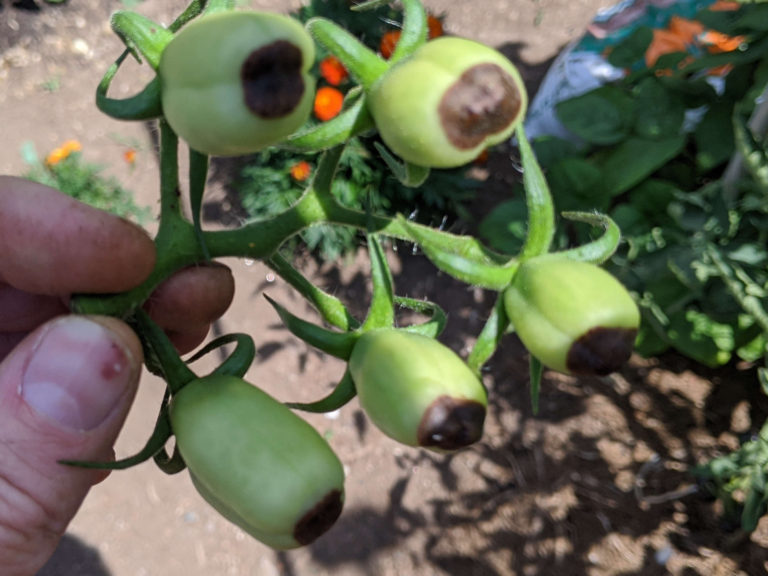Blossom End Rot
Disease Identification
Description
Blossom end rot is not a disease but a disorder in fruiting plants which results in the blossom end of the fruit turning brown and rotting. It always starts on the blossom end of the fruit and if not removed will rot on the vine. It nearly always affects groups of fruit as opposed to just one.
- Leaves: Not affected
- Stems: Not affected
- Fruit: Black spots appear on the bottoms (blossom end) of fruit. Generally groups of fruit will be affected at the same time.
Images
Affected Plants
- Tomatoes
- Eggplant
- Peppers
- Summer Squash
Disease Control
Life Cycle
Blossom end rot is not a disease but a disorder due to poor environmental conditions. The direct cause of the problem is a lack of calcium, but a deficiency in that mineral is rarely the underlying source. The soil in Rose Tree Garden, for the most part, contains adequate amounts of calcium for most plants. However, if a plant is unable to access that available supply of calcium, blossom end rot could result.
In order for plants to grow properly, the roots need to be able to supply a steady amount of water to the plant. This water is used as a way to carry nutrients (including calcium) throughout the plant. If this flow is interrupted in any way, detrimental effects could result, one of which being blossom end rot. Most gardeners know that if the soil is dry, roots won’t be able to supply enough water to the plant. However, what isn’t commonly known is that the opposite is also true. If the roots are surrounded by too much water, they can begin to rot, resulting in fewer roots and an inability for the plant to obtain enough water. This is why it is so important to monitor soil moisture not only on the surface, but a few inches down to ensure the plant has an adequate supply of water at all time.
Management
The management recommendations below will help limit the impact of blossom end rot on your plants.
- Avoid too Much or too Little Water: When watering, you want to ensure the soil around your plants is neither saturated with water or extremely dry. These two extremes can cause issues with water and therefore nutrient uptake resulting in blossom end rot. Before watering, ensure the soil is dry a few inches down. If this is the case, water the ground very slowly (to prevent runoff) over an hour (to ensure water penetrates deeply into the soil). A general rule is to ensure the plants get around 1 inch of water per week. Regularly monitor your plants to ensure proper soil moisture.
- Do Not Overfertilize: Excessive applications of nitrogen fertilizer (especially quick release non-organic types) can result in rapid growth of leaves pulling calcium away from the fruit and causing blossom end rot. When fertilizing, it is best to use a slow-release organic fertilizer to allow the plant to slowly take in the nutrients. One application at planting time should be adequate. Obtain a soil test before applying more.
- Test Your Soil: The only way to determine the calcium concentration in your soil is to obtain a soil test. These are easily available through the Delaware County Extension Office for a small fee. These tests will also be able to tell you the pH of your soil which is important in regulating nutrient uptake. These two values are important in preventing blossom end rot
- Resistant Varieties: Some plants have been bred to be resistant to blossom end rot. While not common, if blossom end rot has been an ongoing problem and the first 3 suggestions haven’t worked, obtaining a resistant variety may be a good approach.
Blossom end rot cannot be slowed or stopped by calcium sprays because the skin of fruit is not able to absorb calcium in this manner. While it will not harm the plant, foliar calcium sprays require time and money which could be spent in other ways that actually benefit your plant.

